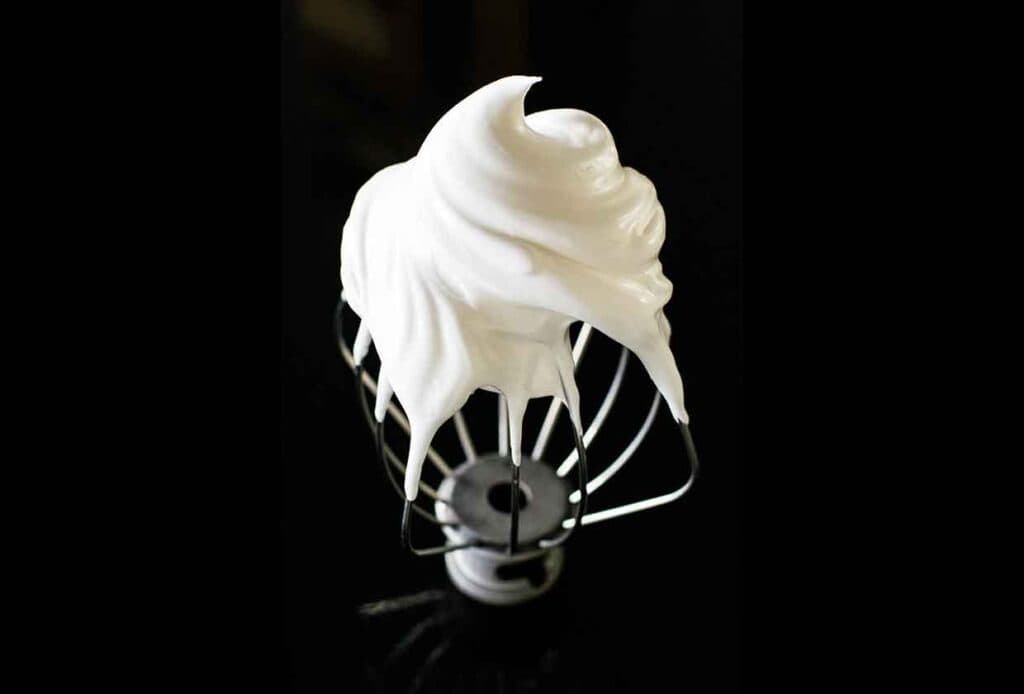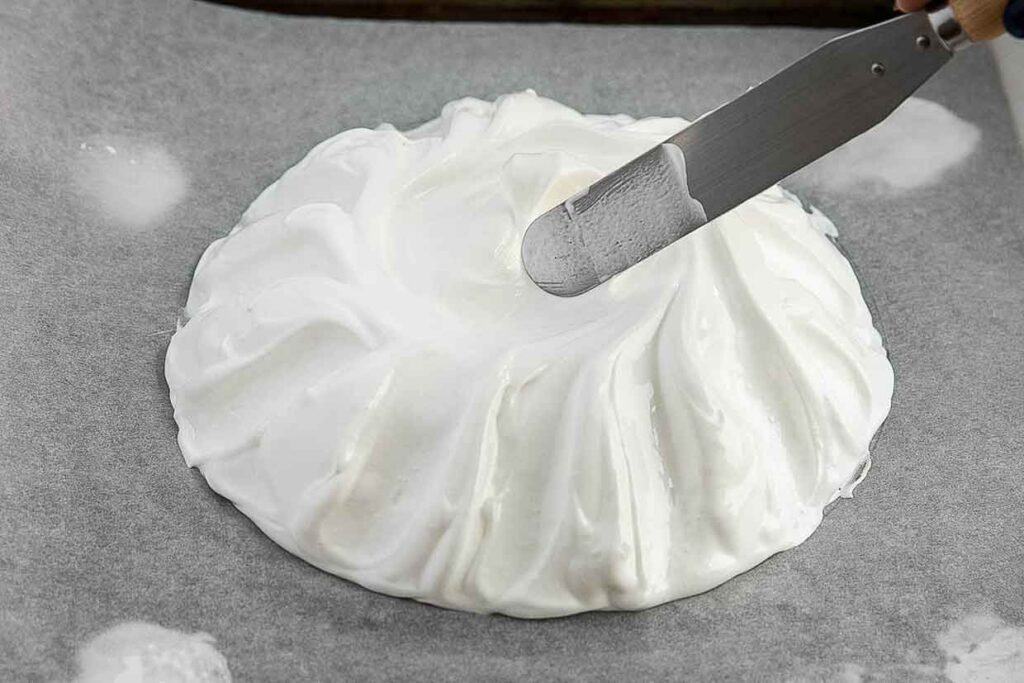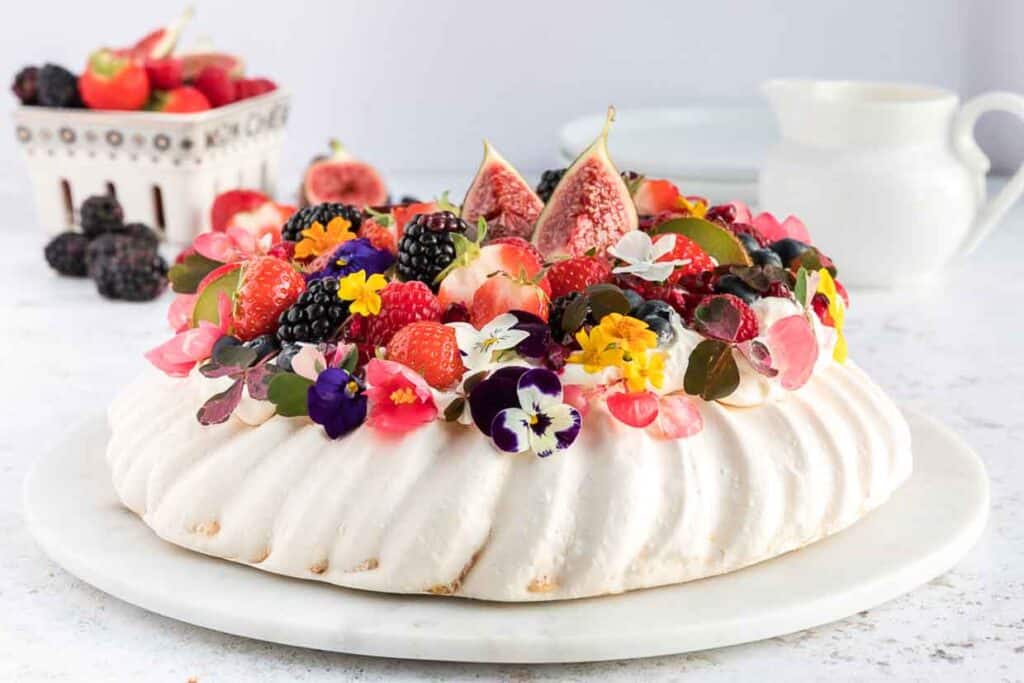Meringue is a deceptively simple confection made from whipped egg whites and sugar, yet it offers various textures and uses in the culinary world. Whether you require a light, airy topping for a pie, a firm base for a pavlova or glossy icing for a cake, there is a meringue-making technique perfect for your baking needs.

What is meringue
Meringue is the result of using sugar to stabilize and sweeten beaten egg whites. These whipped egg whites serve as leaveners for souffles, sponge cakes and waffle batters and give mousse its light, airy texture.
In technical terms, the proteins in the egg whites are denatured and coagulated to transform from a thick gelatinous goo into a light, fluffy foam. Adding sugar to the whipped egg whites causes the foam to take on a more stable structure that can hold stiff or firm peaks and retain their shape longer.
Meringue types and techniques
There are three primary types of meringue: French, Italian and Swiss, each with unique characteristics and preparation techniques. Each contains the same ingredients: egg whites, sugar and an optional acid such as lemon juice, vinegar or cream of tartar. The method required depends on the intended use, although some applications work with multiple methods.
FDL’S 75 Best Bites

Our cookbook with 75 tasty recipes will be your go-to kitchen companion for easy dinners with ad-free recipes right at your fingertips. Crafted by experienced chefs and recipe developers, this collection offers a treasure trove of tried-and-true dishes that make mealtime a breeze.
Get the Recipe: FDL’S 75 Best Bites
French meringue
Common, or French meringue, is the least stable type. To make French meringue, beat the egg whites until frothy, then add the sugar in either a gradual stream or small doses until it is all incorporated. The egg whites can then be whipped to soft, medium or stiff peaks as needed for your recipe.
French meringue does not require cooking, so the egg whites remain raw. Therefore, it is best only in applications where the meringue will be further cooked, such as a show-stopping Pavlova, airy angel food cake or luscious lemon meringue pie.
Swiss meringue
More stable than French meringue, Swiss meringue is made by heating the egg whites and sugar together before whipping. To make Swiss meringue, combine the egg whites and sugar in a mixer bowl and place it over simmering water. Constantly whisk the egg whites and sugar until the sugar has melted and the mixture’s temperature reaches at least 140 F. Then, transfer the bowl to your mixer and whip on medium to medium-high until you achieve the desired peaks.
Swiss meringue is a cooked meringue. However, 140 F is not hot enough to eat safely without further baking. If you use this meringue to top a baked tart, it is fine to stop at 140 F. However, if you use it to make Swiss buttercream icing, you must cook the egg whites to at least 165 F.
Swiss meringue is arguably the easiest preparation method and has the widest margin for error when whipping to stiff peaks. You can use it in many applications that call for French meringue, and if cooked to a high enough temperature, you can also use it for unbaked applications.
“Swiss meringue is my favorite when it comes to topping cream pies. I prefer it over the uncooked meringue because it’s more stable and doesn’t weep or deflate. It’s simple to make by heating it gently over a hot water bath, then whipping it until it’s smooth and creamy. The meringue turns out beautifully white. You can turn this meringue into an amazing buttercream icing too.”
— Jere’ Cassidy, One Hot Oven

Italian meringue
The most stable of our three primary types, Italian meringue, calls for whipping hot sugar syrup into egg whites. To make Italian meringue, use three-quarters of the sugar and combine it with half as much water by volume to create a sugar syrup. Heat this sugar syrup until it reaches 240 F.
Meanwhile, combine the remaining sugar with the egg whites and beat to soft peaks. Once the sugar syrup reaches the correct temperature, gradually pour it into the whipped egg whites with the mixer running. Once incorporated, continue to beat until you reach the desired peaks.
Italian meringue is the most demanding, requiring careful timing and safe handling of extremely hot sugar syrup. It produces glossy voluminous peaks that hold more successfully for longer periods of time. It is fully cooked and great for baked applications, but you can also use it in unbaked applications such as ice cream bases, piped into decorative shapes or to make Italian buttercream. Italian meringue is also a homemade substitute for marshmallow creme.
A note on meringue powder
Meringue powder is a processed baking ingredient often found in the baking aisle and is becoming more common in the average baker’s pantry. It is made by dehydrating pasteurized egg whites, combining them with sugar and, typically, adding emulsifiers, stabilizers and artificial flavors.
Meringue powder is a substitute for meringue and is often recommended in recipes that are not baked or cooked. However, it is not an appropriate substitute for those avoiding eggs, and the additional additives included by many mainstream brands make it an ultra-processed food. To use meringue powder, simply reconstitute it with water, per the instructions in your recipe or the product packaging.

Meringue-making tips
When making meringue from scratch, there are some fundamental rules to follow to achieve perfect results. Here are six tips to help you achieve success.
- You must be very careful when separating the egg whites and yolks, as even the smallest amount of yolk can prevent the egg whites from foaming correctly. Use the leftover egg yolks to make a fancy creme brulee or luscious lemon curd. Alternatively, you can add them to your morning omelet for an extra flavor boost.
- Egg whites separate best when cold but whip most successfully at room temperature. You can let the egg whites sit out to come up to temp after separating them or gently heat them over simmering water until around 70 F.
- The bowl and whip must be completely clean and free of grease. Often, bakers wipe the equipment with vinegar and then rinse with very hot water to ensure all traces of fat are gone.
- The egg whites will expand in volume between eight and ten times their un-whipped size. Ensure your mixing bowl is not overloaded and has room for the egg whites to whip properly.
- Acids like vinegar, lemon or cream of tartar can help stabilize the whipped egg whites further and can also serve to temper the sweetness of the meringues. It’s optional, but if you include it or other flavor enhancers like vanilla, add them before whipping.
- Patience is key. Start the mixer on low until the egg whites start to foam, then increase the speed. Stop the mixer when they reach soft, medium or firm peaks, as desired. If you continue to whip the egg whites after reaching firm peaks, they can collapse and take on a dull, grainy texture.
Homemade meringue medley
Whether used as a topping for pies and tarts or as the star of its own dessert, meringue’s light and airy texture and delicately sweet flavor make it a beloved indulgence for many. Regardless of the meringue type you choose — French, Swiss or Italian — each is made from simple ingredients, creating endless possibilities to incorporate meringue into your rotating menu of homemade desserts.
Renee N Gardner is the creative mastermind behind Renee Nicole’s Kitchen, a recipe blog based on seasonal ingredients, dedicated to helping home cooks build their kitchen confidence to become home chefs. When Renee isn’t writing, developing recipes or photographing food, you’ll find her in the garden, traveling or enjoying the outdoors with her husband, son and two dogs.